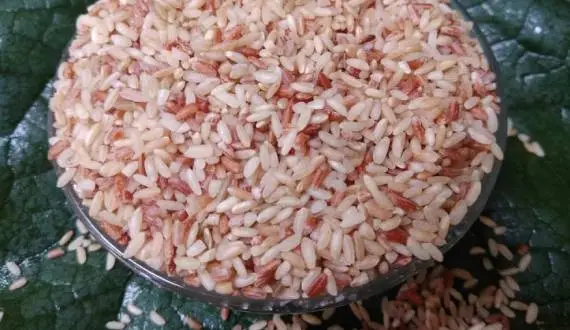Historical Significance
The name "Rajamudi" has its roots in history, where "Raja" means king and "mudi" means crown. This variety of rice was once the preferred grain of the Wodeyar kings of Mysore. It was considered a royal delicacy, often used in royal kitchens for its rich flavor and nutritional value. Over time, the cultivation of Rajamudi rice became synonymous with the rich agricultural heritage of Karnataka.
Cultivation and Characteristics
Rajamudi rice is primarily grown in the Mysore and Hassan regions of Karnataka. It is a semi-polished rice variety, which means that the outer layer of the grain is only partially removed during processing. This retains most of the bran layer, making it rich in fiber and other nutrients.
The grains of Rajamudi rice are small to medium in size and have a reddish-brown hue due to the presence of anthocyanins, which are known for their antioxidant properties. This rice is also drought-resistant and requires less water compared to other varieties, making it a sustainable choice for farmers in the region.
Nutritional Benefits
1. High Fiber Content: The semi-polished nature of Rajamudi rice ensures that it retains a high amount of dietary fiber, which aids in digestion and helps maintain a healthy gut.
2. Rich in Antioxidants: The reddish-brown color of the rice indicates the presence of anthocyanins, which have antioxidant properties that help in reducing inflammation and protecting against chronic diseases.
3. Low Glycemic Index: Rajamudi rice has a low glycemic index, which means it releases glucose slowly into the bloodstream, making it a suitable option for people with diabetes and those looking to manage their blood sugar levels.
4. Nutrient-Rich: This rice variety is also rich in essential nutrients like magnesium, zinc, and iron, contributing to overall health and well-being.
Culinary Uses
Rajamudi rice has a distinct flavor and texture that makes it a favorite in traditional South Indian cuisine. Here are some popular culinary uses:
1. Rice Dishes: Rajamudi rice is often used to prepare traditional rice dishes like pulao, biryani, and khichdi. Its unique taste and texture add a special touch to these recipes.
2. Plain Rice: It can also be served as plain rice to accompany various curries and dals. The slightly nutty flavor of Rajamudi rice enhances the overall dining experience.
3. Rice Porridge: Known for its health benefits, Rajamudi rice is used to prepare rice porridge or congee, which is often consumed as a nutritious breakfast or a light meal.
4. Traditional Sweets: In Karnataka, Rajamudi rice is used to prepare traditional sweets like payasam (a type of rice pudding) and other festive delicacies.
Preservation and Promotion
The cultivation and promotion of Rajamudi rice are crucial for preserving the agricultural heritage of Karnataka. Efforts are being made to support local farmers through sustainable farming practices and to promote this heritage rice variety in both domestic and international markets.
Organizations and cooperatives are working to create awareness about the benefits of Rajamudi rice and to ensure fair trade practices that benefit the farmers. By choosing Rajamudi rice, consumers can contribute to preserving an essential part of Karnataka's cultural and agricultural legacy.
Conclusion
Rajamudi rice is more than just a grain; it is a testament to the rich cultural and agricultural history of Karnataka. Its unique flavor, nutritional benefits, and historical significance make it a valuable addition to any kitchen. By incorporating Rajamudi rice into your diet, you not only enjoy a delicious and healthy meal but also support the preservation of a precious heritage.


